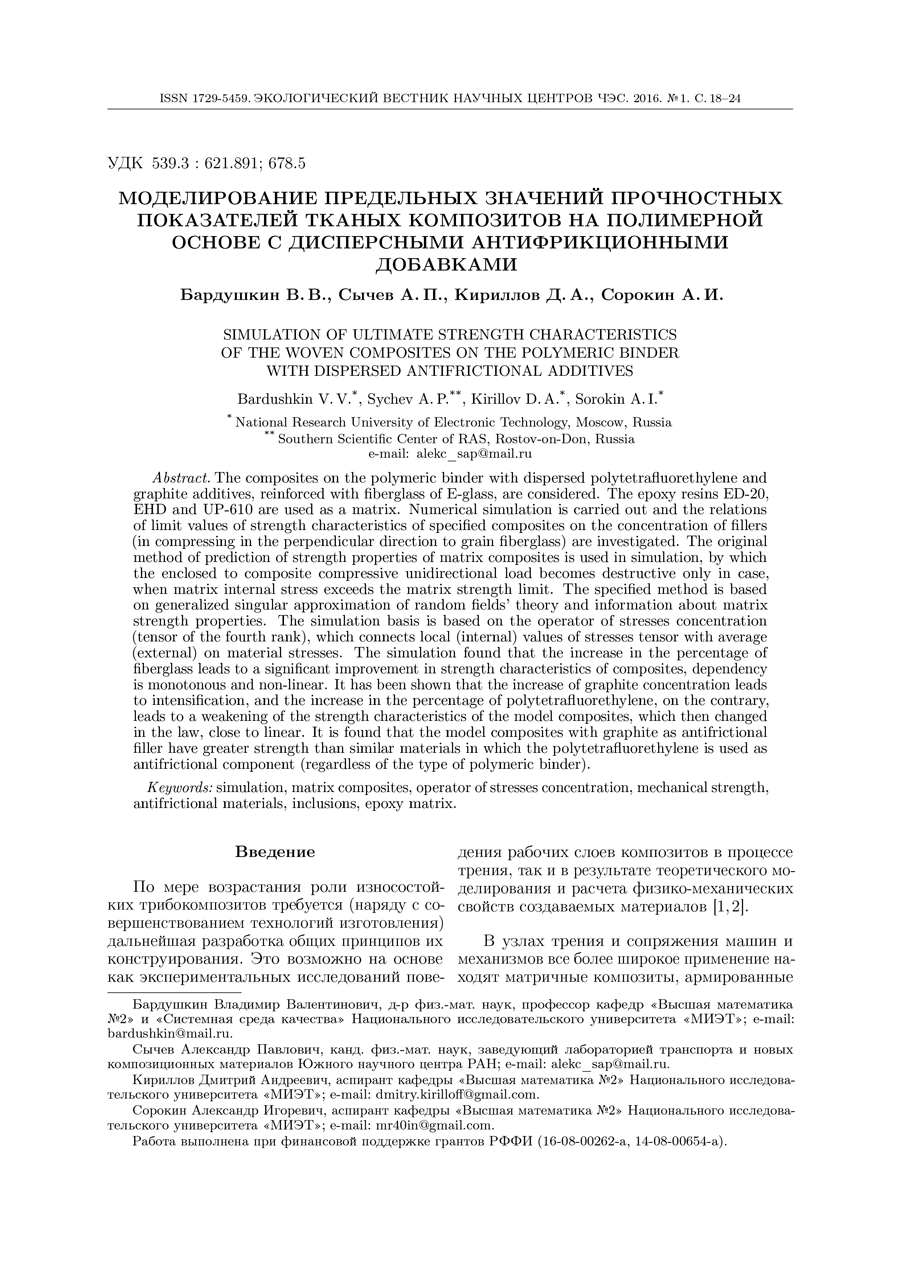Simulation of ultimate strength characteristics of the woven composites on the polymeric binder with dispersed antifrictional additives
UDC
539.3 : 621.891; 678.5Abstract
The composites on the polymeric binder with dispersed polytetrafluorethylene and graphite additives, reinforced with fiberglass of E-glass, are considered. The epoxy resins ED-20, EHD and UP-610 are used as a matrix. Numerical simulation is carried out and the relations of limit values of strength characteristics of specified composites on the concentration of fillers (in compressing in the perpendicular direction to grain fiberglass) are investigated. The original method of prediction of strength properties of matrix composites is used in simulation, by which the enclosed to composite compressive unidirectional load becomes destructive only in case, when matrix internal stress exceeds the matrix strength limit. The specified method is based on generalized singular approximation of random fields' theory and information about matrix strength properties. The simulation basis is based on the operator of stresses concentration (tensor of the fourth rank), which connects local (internal) values of stresses tensor with average (external) on material stresses. The simulation found that the increase in the percentage of fiberglass leads to a significant improvement in strength characteristics of composites, dependency is monotonous and non-linear. It has been shown that the increase of graphite concentration leads to intensification, and the increase in the percentage of polytetrafluorethylene, on the contrary, leads to a weakening of the strength characteristics of the model composites, which then changed in the law, close to linear. It is found that the model composites with graphite as antifrictional filler have greater strength than similar materials in which the polytetrafluorethylene is used as antifrictional component (regardless of the type of polymeric binder).
Keywords:
simulation, matrix composites, operator of stresses concentration, mechanical strength, antifrictional materials, inclusions, epoxy matrixAcknowledgement
References
- Mashkov Yu.K., Ovchar Z.N., Baybaratskaya M.Yu., Mamaev O.A. Polimernye kompozicionnye materially v tribotehnike [Polymer composite materials in tribotechnics]. Moscow, Nedra Publ., 2004, 261 p. (In Russian)
- Kolesnikov V.I., Bardushkin V.V., Yakovlev V.B., Sychev A.P., Kolesnikov I.V. Mikromehanika polikristallov i kompozitov (naprjazhenno-deformirovannoe sostojanie i razrushenie) [Micromechanics of polycrystals and composites (stress-strain state and destruction)]. Rostov-on-Don, Rostov State Transport University Publ., 2012, 288 p. (In Russian)
- Buryachenko V.A. Micromechanics of heterogeneous materials. Berlin, Springer - Verlag, 2007, 686 p.
- Bardushkin V.V., Sychev A.P., Sychev A.A., Dan'kov V.V. Jeffektivnye uprugie harakteristiki tkanyh kompozitov na polimernoj osnove s antifrikcionnymi dispersnymi dobavkami [Effective elastic characteristics of the woven composites on the polymeric binder with dispersed antifriction additives]. Vestnik Yuzhnogo nauchnogo tsentra RAN [Bulletin of the Southern Research Center of the RAS], 2013, vol. 9, no. 4, pp. 26-31. (In Russian)
- Berezin A.V., Kozinkina A.I. Osobennosti diagnostiki povrezhdenij i ocenki prochnocti kompozitov [The features of damage diagnostics and estimation of the strength of the composites]. Mehanika kompozicionnyh materialov i konstrukcij [Mechanics of Composite Materials and Structures], 1999, vol. 5, no. 1, pp. 99-120. (In Russian)
- Kolesnikov V.I., Bardushkin V.V., Yakovlev V.B., Sychev A.P., Kirillov D.A., Sorokin A.I. O metode prognozirovanija predel'nyh prochnostnyh harakteristik matrichnyh kompozitov, osnovannom na ispol'zovanii operatora koncentracii naprjazhenij [About a method of predicting of ultimate strength characteristics of the matrix composites, based on use of the operator of stresses concentration]. Ekologicheskiy vestnik nauchnykh tsentrov Chernomorskogo ekonomicheskogo sotrudnichestva [Ecological Bulletin scientific centers of the Black Sea Economic Cooperation], 2014, no. 1, pp. 45-51. (In Russian)
- Shermergor T.D. Teorija uprugosti mikroneodnorodnyh sred [Micromechanics of inhomogeneous medium]. Moscow, Nauka Publ., 1977, 399 p. (In Russian)
- Pobedrya B.E., Gorbachev V.I. Koncentracija naprjazhenij i deformacij v kompozitah [Concentration of stresses and deformations in the composites]. Mehanika kompozitnyh materialov [Mechanics of Composite Materials], 1984, no. 2, pp. 207-214. (In Russian)
- Maslov B.P. Koncentracija naprjazhenij v izotropnoj matrice, armirovannoj anizotropnymi vkljuchenijami [Concentration of stresses in an isotropic matrix reinforced anisotropic inclusions]. Prikladnaja mehanika [Applied Mechanics], 1987, vol. 23, no. 10, pp. 73-79. (In Russian)
- Bardushkin V.V., Yakovlev V.B., Kolesnikov I.V., Sychev A.P., Sychev A.A., Flek B.M. Koncentracija naprjazhenij i deformacij v antifrikcionnyh tkanyh kompozitah [Stress and strain concentration in the antifrictional woven composites]. Trenie i smazka v mashinah i mehanizmah [Friction and lubrication in machinery], 2013, no. 3, pp. 7-13. (In Russian)
- Kolesnikov V.I., Yakovlev V.B., Bardushkin V.V., Sychev A.P. O prognozirovanii raspredelenij lokal'nyh uprugih polej v neodnorodnyh sredah na osnove obobschennogo singuljarnogo priblizhenija [On the prediction of local elastic fields' distributions in non-uniform media on the basis of a generalized singular approximation]. Vestnik Juzhnogo nauchnogo centra RAN [Bulletin of the Southern Research Center of the RAS], 2015, vol. 11, no. 3, pp. 11-17. (In Russian)
- Lapitsky V.A., Kricuk A.A. Fiziko-mehanicheskie svojstva jepoksidnyh polimerov i stekloplastikov [Physical and mechanical properties of the epoxy polymers and fiberglasses]. Kiev, Naukova Dumka Publ., 1986, 92 p. (In Russian)
- Gutnikov S.I., Lazorjak B.I., Seleznev A.N. Stekljannye volokna [Glass fibers]. Moscow, Moscow State University Publ., 2010, 53 p. (In Russian)
- Pan'kov A.A. Metody samosoglasovanija mehaniki kompozitov [Methods of self-consistency mechanics of composites]. Perm, Perm State Technical University Publ., 2008, 253 p. (In Russian)
Downloads
Issue
Pages
Submitted
Published
How to Cite
Copyright (c) 2016 Bardushkin V.V., Sychev A.P., Kirillov D.A., Sorokin A.I.

This work is licensed under a Creative Commons Attribution 4.0 International License.




